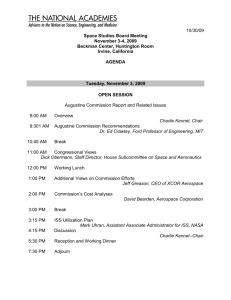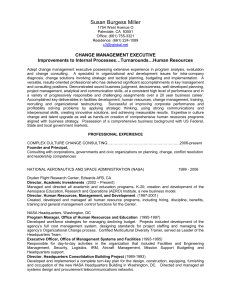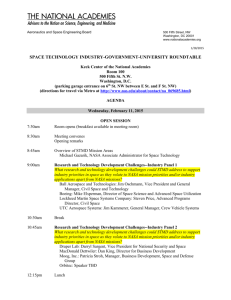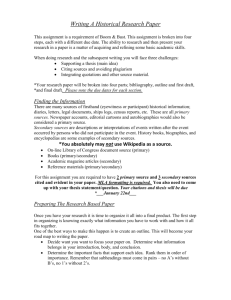New Horizons Forum Speaker Biographies
advertisement
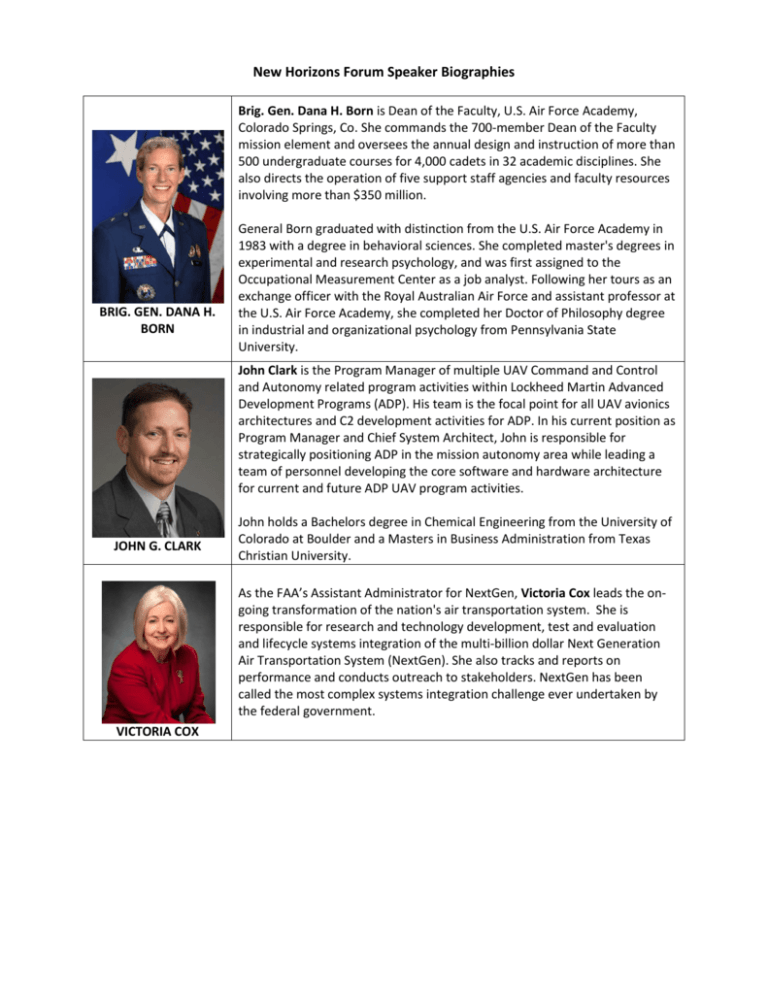
New Horizons Forum Speaker Biographies Brig. Gen. Dana H. Born is Dean of the Faculty, U.S. Air Force Academy, Colorado Springs, Co. She commands the 700-member Dean of the Faculty mission element and oversees the annual design and instruction of more than 500 undergraduate courses for 4,000 cadets in 32 academic disciplines. She also directs the operation of five support staff agencies and faculty resources involving more than $350 million. BRIG. GEN. DANA H. BORN General Born graduated with distinction from the U.S. Air Force Academy in 1983 with a degree in behavioral sciences. She completed master's degrees in experimental and research psychology, and was first assigned to the Occupational Measurement Center as a job analyst. Following her tours as an exchange officer with the Royal Australian Air Force and assistant professor at the U.S. Air Force Academy, she completed her Doctor of Philosophy degree in industrial and organizational psychology from Pennsylvania State University. John Clark is the Program Manager of multiple UAV Command and Control and Autonomy related program activities within Lockheed Martin Advanced Development Programs (ADP). His team is the focal point for all UAV avionics architectures and C2 development activities for ADP. In his current position as Program Manager and Chief System Architect, John is responsible for strategically positioning ADP in the mission autonomy area while leading a team of personnel developing the core software and hardware architecture for current and future ADP UAV program activities. JOHN G. CLARK John holds a Bachelors degree in Chemical Engineering from the University of Colorado at Boulder and a Masters in Business Administration from Texas Christian University. As the FAA’s Assistant Administrator for NextGen, Victoria Cox leads the ongoing transformation of the nation's air transportation system. She is responsible for research and technology development, test and evaluation and lifecycle systems integration of the multi-billion dollar Next Generation Air Transportation System (NextGen). She also tracks and reports on performance and conducts outreach to stakeholders. NextGen has been called the most complex systems integration challenge ever undertaken by the federal government. VICTORIA COX Mr. Fisherkeller has worked in the unmanned systems industry since the mideighties on many game changing defense systems including the Tomahawk cruise missile, hypersonic aircraft, the Minuteman ballistic missile and is currently an industry leader in the development of an open-architecture for command and control of Unmanned Aerial Systems (UAS) including the Global Hawk, X-47B UCAS and Fire Scout VTUAV programs. KERRY FISHKELLER Mr. Fisherkeller serves on the Executive Board of the UCS Architecture Working Group which is sponsored by the Office of Secretary of Defense (OSD) and is a Subcommittee Co-Chair for Application Platforms. He represents Northrop Grumman’s UAS program interests on the UCS Architecture Working Group as Program Manager and as Chief Architect leads Northrop’s technical team in development of the common UCS architecture reference model. Building a UCS architecture to meet OSD’s business-driven goals of better buying power through acquisition efficiency requires a combination of enterprise, systems, and software architecture techniques to maximize architecture commonality and interoperability for current and future UAS. Douglas Gregory is a Distinguished Member of Technical Staff at General Dynamics Advanced Information Systems (GDAIS) with expertise in the strategy, management and development of Open Architectures. Mr. Gregory is chairman of the OSD UAS Control Segment (UCS) Working Group (since September 2009) and is one of its inaugural members. He was also chairman of the SAE Aerospace Avionic Systems Division (ASD) (5 years) and chairman of its Aircraft Systems and System Integration Committee (AS-1) (5 years). He has chaired three subgroups of the NATO Industrial Advisory Group (NIAG) which studied Open Architectures for aircraft weaponization and UAS weaponization. DOUGLAS GREGORY JAMES I. HILEMAN Mr. Gregory has been Principal Investigator on a number of Open Architecture research programs for Army, Air Force and Navy customers. He holds Bachelor of Science and Master of Engineering degrees from the University of Bath in England. Dr. Jim Hileman is the Chief Scientific and Technical Advisor for Environment for the Federal Aviation Administration. Prior to this, he was the Associate Director of the Partnership for AiR Transportation Noise and Emissions Reduction (PARTNER), a leading aviation cooperative research organization and an FAA/NASA/Transport Canada-sponsored Center of Excellence. As a principal research engineer within the Department of Aeronautics and Astronautics at MIT, his research work focused on modeling the impacts of using alternative jet fuels and innovative aircraft concepts on energy efficiency, noise, air quality and global climate change. He received his B.S., M.S., and Ph.D. in Mechanical Engineering from The Ohio State University. He was awarded the 2010 FAA Excellence in Aviation Research award for his team’s work on alternative fuels and he was also the FAA Centers of Excellence Faculty of the Year Award recipient in 2010. BRIAN T. HOLGUIN ANTIONIO ELIAS Brian T. Holguin is an Operations Supervisor for the FAA at Washington Air Route Traffic Control Center. Brian has over 22 years of operational experience in air traffic control and air traffic management—including assignments at the Air Traffic Control System Command Center, Oakland and Washington Air Route Traffic Control Centers, and Air Traffic Safety Oversight. His program management experience includes assignments at FAA Headquarters in Airspace and RNAV Procedures, Planning and Procedures, and Policy and Standards. Brian is a senior member of AIAA, former chairman of the Air Transportation Systems Technical Committee, and FAA Co Lead on the NASA/FAA Dynamic Airspace Configuration Research Transition Team. Antonio Elias is Executive Vice President and General Manager of Orbital's Advanced Programs Group which includes its National Security Space and Human Space Systems divisions. Previous positions at Orbital include VP, Programs and VP, Engineering. In the late 80's he led the technical team that conceived and developed the Pegasus Air-Launch vehicle. Before joining Orbital in 1986 he was a faculty member at the Massachusetts Institute of Technology's Department of Aeronautics and Astronautics from which he holds Bachelor's Master's, Engineer's and Ph. D. degrees, and member of the technical staff at the C.S. Draper Laboratory. He is a member of the National Academy of Engineering, AIAA Fellow and co-recipient of the 1991 National Medal of Technology. Dr. Mike Leahy is the Common Mission Management System (CMMS) Program Manager for the Advanced Programs and Technology (AP&T) Division of Northrop Grumman Aerospace Systems. Prior to his August 2010 appointment to his current position, Mike was the Chief Architect for AP&T, responsible for establishing the architectural framework standard for all AP&T programs to ensure a consistent and highly competitive level of design, development and transition for each capability. Prior to joining Northrop Grumman in September 2007, Colonel Leahy had a distinguished 27-year U.S. Air Force career and made significant contributions to the advancement of aerospace technology and advanced systems. He was a professor at the Air Force Institute of Technology; lead the DARPA/USAF UCAV ATD (X-45A) from conception through first flight, served as director of the Air Vehicles Directorate at the Air Force Research Laboratory and ViceDirector of the 448th Combat Sustainment Wing. MICHAEL B. LEAHY, JR. Mike is the AIAA 2010 Hap Arnold Award recipient for sustained excellence in aeronautical program management. He holds a bachelor’s degree in electrical engineering from the Stevens Institute of Technology, a master’s degree in electrical engineering from the University of New Mexico, a master’s degree in national resource strategy from the Industrial College of the Armed Forces, and a doctorate in electrical engineering from the Rensselaer Polytechnic Institute. Michael Luther has over 42 years of industry and government experience in the development and management of space based scientific remote sensing systems. He spent 12 years in industry prior to his 30 years of government service with the National Aeronautics and Space Administration (NASA). He joined NASA’s Langley Research Center in January 1981 for the development, launch, and early mission operations of a series of Earth remote sensing instruments. Since joining NASA Headquarters in 1987, Mr. Luther has held a series of positions with increasing responsibilities including Upper Atmosphere Research Satellite Program Manager, Earth Science Division Flight Program Director, Deputy Associate Administrator in the Office of Earth Science and Deputy Associate Administrator for Programs in the Science Mission Directorate (SMD). MICHAEL R. LUTHER Mr. Luther has received Distinguished (2002) and Meritorious (1998) Presidential Rank Awards in recognition of his managerial and leadership skills. He received the NASA Outstanding Leadership Medal in 2005, the NASA Exceptional Service Medal in 1992 and the NASA Medal for Exceptional Engineering Achievement in 1985. He attended the Harvard University John F. Kennedy School of Government in the fall of 1990 as a Senior Executive fellow. Mr. Luther received his B. S. degree in mathematics from BirminghamSouthern College in 1967, and his M.S. degree in applied mathematics from Auburn University in 1969. Mr. Luther lives with his wife, Judy, in Takoma Park, Maryland. They have a grown son Matthew living in Wisconsin. Mrs. McBride has spent more than 20 years in program management and engineering in the aerospace and telecommunication industries. She is presently the Executive Director for the Iridium NEXT Program Management Office (PMO) and Launch Segment. In this position she developed the Iridium NEXT program office, and leads the launch strategy and supplier selection. She is now managing the Iridium NEXT PMO responsible for maintaining, controlling and reporting on the Iridium NEXT budget, cost, schedule and risk. She is also responsible for the management and oversight of the launch service providers (LSPs), SpaceX and Kosmotras, and managing the interface between the satellite prime contractor, Thales Alenia Space, and the LSPs. SUZI MCBRIDE Prior to joining Iridium, she held the position of Program Manager at General Dynamics (now Orbital Sciences Corporation) where she managed NASA and U.S. Air Force satellite programs. Before coming to General Dynamics, Mrs. McBride was a Program Director at Motorola. During her time at Motorola she managed large new technology cellular system implementations in different locations around the world. She also worked for six years on the Iridium program in Motorola’s Satellite Communications group as a senior engineer in satellite manufacturing and launch. Mrs. McBride received her MBA from the University of Tennessee in the Executive Aerospace program and her dual undergraduate degrees, a B.S. in Industrial Engineering from Columbia University and a B.A. in Management Engineering from Claremont McKenna College. She also holds a masters degree in Program Management from George Washington University and is PMI certified. LESTER MCFAWN Lester McFawn is Director, Wright Brothers Institute, Dayton, Ohio, USA. The Wright Brothers Institute (WBI) is a leader in applying advanced innovation tools, processes, environments and multidisciplinary collaborations to solve challenging problems. Previously, he was a member of the Federal Government’s Senior Executive Service, serving in key Air Force leadership positions in aerospace research, development and acquisition. From 2003 to 2008 he was Executive Director, Air Force Research Laboratory. In this position he led the Air Force’s $3.7B science and technology program; 10 R&D business units; and a workforce of 9,900 of the world’s top scientists, engineers and support staff. He previously held Director positions with responsibility for policy, strategic planning, manpower, organizational planning, and out year budget development for the Air Force’s Air Armament Center and Air Force Materiel Command, both multi-billion dollar enterprises. As Director, Sensors Directorate, Air Force Research Laboratory, he had responsibility for the Air Force’s total science and technology program in sensors and electronics. Mr. McFawn holds a Masters Degree in computer, information and control engineering from the University of Michigan, and a Masters Degree in electronics engineering from Florida State University. He has received numerous awards including the Outstanding Civilian Career Service Award, Presidential Rank Award for Meritorious Executive, Defense Acquisition Executive Certificate of Achievement, and 2010 Non Profit Business of the Year in the Greater Dayton Region. Will is the Vice President for Special Projects at Sir Richard Branson's Virgin Galactic, the world's first spaceline. Virgin Galactic is building on the legacy of the award-winning SpaceShipOne, bringing a fleet of commercial spacecraft into service for private, civil, and scientific passengers. He also serves as a Trustee of the Students for the Exploration and Development of Space (SEDS), the world's largest student space organization Will is a graduate of Harvard University, the NASA Academy, and the International Space University. From 2005 - 2011, he worked at the X PRIZE Foundation, the world-leading incentive prize organization. As Senior Director of Space Prizes, he served as the primary author and manager of the $30 million Google Lunar X PRIZE and the $2 million Northrop Grumman Lunar Lander X CHALLENGE. He has also worked at Harvard and Brown Universities, the Futron Corporation, and the United Nations, and was the co-founder and Editor in Chief of SpaceAlumni.com. WILLIAM POMERANTZ Will is married to Diana Trujillo, an engineer at NASA's Jet Propulsion Laboratory. Will and Diana have lived in the Los Angeles area since 2008. Randall Rothe’s experience as Senior Manager for Boeing’s Advanced Unmanned Air Systems - Mission Systems Team, in Boeing's Phantom Works organization puts him on the leading edge of innovation. With more than 31 years engineering and software management experience related to UAS Mission Management, Mission Planning and Control Systems, Mr. Rothe has worked on some of the most innovative aviation projects undertaken by the aerospace leader. Mr. Rothe is currently the program manager for the UAS C2 Standards Initiative and is responsible for the development of the C2 capability for Boeing’s unmanned Phantom Eye and Vulture (HALE- High Altitude Long Endurance) aircraft. RANDALL L. ROTHE Mr. Rothe has a Bachelor's Degree in Mathematics from Southwestern College, Winfield, Kansas, a Masters Degree in Aeronautical Science from Embry-Riddle Aeronautical University, Daytona Beach, Florida, and a Masters Degree in Management Information Systems from Friends University, Wichita Kansas As the Vice President for Aerospace Systems, Mr. Schlickenmaier leads Crown Consulting, Inc., efforts to oversee Crown’s support to the National Aeronautics and Space Administration (NASA), as well as supporting Crown’s efforts on Federal Aviation Administration (FAA) air traffic and aviation safety programs. Mr. Schlickenmaier is responsible for supporting the NASA Glenn Research Center with the Business Development and Partnership Program Support contract, a 3-year contract that provides strategic business and partnership development, program and project management support, as well as critical technical assessments of NASA programs. Mr. Schlickenmaier is also responsible supporting the NASA Headquarters Strategic Planning and Program Office Technical Support contract, a 5-year contract with the Aeronautics Research Mission Directorate to provide them with strategic planning, program management and subject matter expert services. This contract also provides technical support the NASA’s role in the Joint Planning and Development Office (JPDO), and it will offer opportunities to broaden this support to include a range of analytic investigations of new air traffic management concepts. HERBERT W. SCHLICKENMAIER Previously, Mr. Schlickenmaier had a 35-year civil service specializing in aviation and aeronautics research beginning in the FAA and concluding with NASA. Prior to his NASA career, Mr. Schlickenmaier worked at the Federal Aviation Administration for more than 17 years, conducting and managing research that supported engineering and operational certification activities. He was internationally recognized for his research in windshear technology, and was enlisted by the National Transportation Safety Board as an expert witness on two accidents in the 1980s. Gen. William L. Shelton is Commander, Air Force Space Command, Peterson Air Force Base, Colorado. He is responsible for organizing, equipping, training and maintaining mission-ready space and cyberspace forces and capabilities for North American Aerospace Defense Command, U.S. Strategic Command and other combatant commands around the world. General Shelton oversees Air Force network operations; manages a global network of satellite command and control, communications, missile warning and space launch facilities; and is responsible for space system development and acquisition. He leads more than 46,000 professionals, assigned to 88 locations worldwide and deployed to an additional 35 global locations. GENERAL WILLIAM L. SHELTON General Shelton entered the Air Force in 1976 as a graduate of the U.S. Air Force Academy. He has served in various assignments, including research and development testing, space operations and staff work. The general has commanded at the squadron, group, wing and numbered air force levels, and served on the staffs at major command headquarters, Air Force headquarters and the Office of the Secretary of Defense. Prior to assuming his current position, General Shelton was the Assistant Vice Chief of Staff and Director, Air Staff, U.S. Air Force, Pentagon, Washington, D.C. As the Deputy Associate Administrator for Integration, James Stofan reports to the Associate Administrator for Education. He shares responsibility for providing executive leadership, functional management and coordination of NASA's education programs and activities. The agency's goal is to meet national education needs and ensure a sufficient talent pool to preserve U.S. leadership in space exploration, aeronautical technology and science. Stofan joined NASA in September 2003, first as the agency’s Informal Education Division Director, and until April 2010 as the Deputy Associate Administrator for Education Integration. Prior to joining NASA, Stofan served as the Senior Vice President for Education Programs at the National Wildlife Federation. Subsequent to joining NWF, Stofan was a faculty member and Director of Distance Education at Johns Hopkins School of Hygiene and Public Health. JAMES STOFAN Stofan has served on the National Partners Council of the Points of Light Foundation, Board of Directors of National Wildlife Productions and on the Executive Committee of the Board of Directors of eNature.com. He is also the past Chair of the Environmental Education Coalition. He is a member of the honor societies Kappa Delta Pi and Phi Kappa Phi. A native of San Francisco, Stofan graduated in 1989 from Johns Hopkins University with a degree in behavioral biology and sociology. He earned a master's degree in instructional technology from the University of Central Florida. As director of the Integrated Systems Research Program Office, Ed Waggoner is responsible for the overall planning, management and evaluation of the directorate's efforts to conduct integrated, system-level research on promising vehicle and operational technologies in a relevant environment that meet energy, environmental and mobility objectives. In addition, he supports the associate administrator in a broad range of mission directorate activities, including strategic and program planning; budget development; program review and evaluation; and external coordination. EDGAR WAGGONER Waggoner began his NASA career in 1982 as a researcher in the theoretical aerodynamics discipline at NASA's Langley Research Center. He has been awarded several NASA Group Achievement Awards and NASA Special Act or Service Awards and has authored or coauthored 44 NASA technical papers, journal articles and conference publications. He is an associate fellow of the American Institute of Aeronautics and Astronautics. Waggoner received a bachelor's degree in aerospace engineering from Auburn University, a master's degree in mechanical engineering from Southern Methodist University, and master's and doctoral degrees in engineering management from George Washington University. Mr. John F. Wagner, DISL, DAF currently holds the position of Chief Technical Director, Launch & Range Systems Directorate, Los Angeles Air Force Base, California. JOHN F. WAGNER Mr. Wagner graduated from the University of Kentucky in 1976 and was commissioned through the Air Force Reserve Officers Training Corps program. During his 30 years of military service he held a variety of assignments in operational, acquisition, and staff units. Assignments included positions at Headquarters Air Force Systems Command; Assistant Secretary of the Air Force for Acquisition, Headquarters Air Force, Commander Detachment 9 Launch Group, and System Program Director Defense Meteorological Satellite Program. He retired as a colonel in September 2006. He entered government civilian service in October 2006. Before assuming his current position, he was the Director of Staff, Space and Missile Systems Center, Los Angeles Air Force Base, California. Mr. Wagner is married to the former Janet L. Pearsall from Detroit MI. They have a daughter, Monique, and a son, Shawn. Dr. Annalisa Weigel is an Assistant Professor of Aeronautics and Astronautics and Engineering Systems at MIT. Dr. Weigel is the Principal Investigator for the Survey of Aerospace Student Attitudes, a data-driven national investigation into the educational motivations and career aspirations of our undergraduate aerospace engineering students. She is an Associate Fellow of the AIAA, chairs the AIAA Public Policy Subcommittee on Workforce and Education, and is a member of the IAF Global Space Workforce Development Committee. ANNALISA WEIGEL She began her professional career as an engineer at Adroit Systems, first supporting the DoD Office of the Space Architect during its stand-up and initial space system architecture design studies in the areas of satellite communications, satellite operations, and launch on demand. Dr. Weigel has five degrees ranging across engineering, policy, and management, with four of them – including her Ph.D. – from MIT. Dr. Carl Wieman was confirmed by the United States Senate to serve as the Associate Director for Science at the White House Office of Science and Technology Policy in September 2010. Dr. Wieman previously divided his time between the University of British Columbia and the University of Colorado. At each institution, he served as both the Director of Collaborative Science Education Initiatives aimed at achieving widespread improvement in undergraduate science education and as a Professor of Physics. From 1984 through 2006, he was a Distinguished Professor of Physics and Presidential Teaching Scholar at the University of Colorado. While at the University of Colorado, he was a Fellow of JILA (a joint federal-university institute for interdisciplinary research in the physical sciences) and he served as the Chair of JILA from 1993-95. Dr. Wieman has conducted extensive research in atomic and laser physics. His research has been recognized with numerous awards including sharing the Nobel Prize in Physics in 2001 for the creation of a new form of matter known as “Bose-Einstein condensation.” CARL WIEMAN Dr. Wieman has also worked extensively on research and innovations for improving science education; he was the founding Chair of the National Academy of Sciences Board on Science Education. He has received numerous awards, including the National Science Foundation’s Distinguished Teaching Scholar Award (2001), the Carnegie Foundation’s U.S. University Professor of the Year Award (2004), and the American Association of Physics Teachers’ Oersted Medal (2007) for his work on science education. Dr. Wieman received his B.S. in Physics from the Massachusetts Institute of Technology in 1973 and his Ph.D. from Stanford University in 1977.
